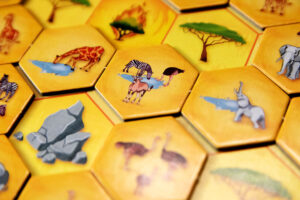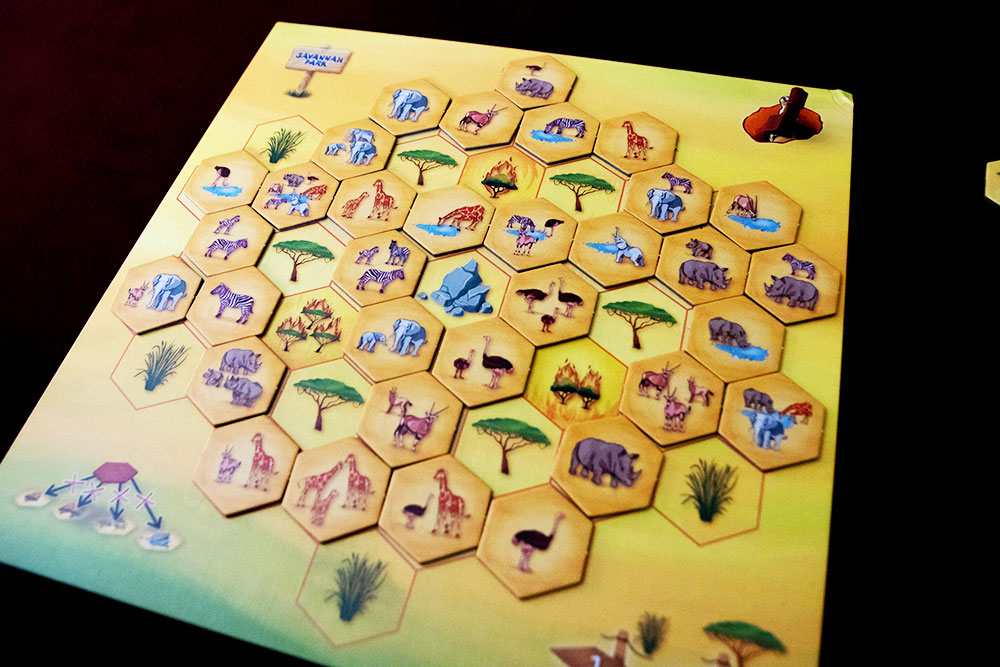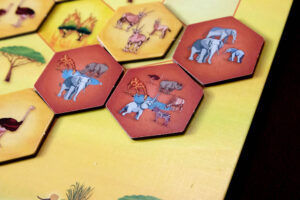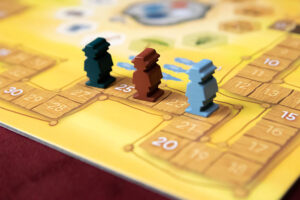 Wolfgang Kramer and Michael Kiesling’s homes must be just absolutely covered in tiles they’ve used in prototyping. They’ve designed countless tile laying games. Hex tiles, square tiles, round tiles. Tiles with animals. Floor tiles. They are really the tiling experts.
Wolfgang Kramer and Michael Kiesling’s homes must be just absolutely covered in tiles they’ve used in prototyping. They’ve designed countless tile laying games. Hex tiles, square tiles, round tiles. Tiles with animals. Floor tiles. They are really the tiling experts.
Savannah Park is another in their discography. Simple to learn, family weight, and covered in cute animals. Savannah Park is a tile-laying game for 1-4 players that takes about 20-40 minutes to play.
Gameplay Overview:
Setup for Savannah Park consists of taking your 33 animal tokens and randomly placing them face up on the sand spaces of your player board. Each player does this separately, giving everyone a different setup. Each tile shows 1-3 animals (there are six different species) and some also show a watering hole. There is also one special tile with all six animals and a watering hole. It’s a very important tile… let’s get to why.

Players will take turns choosing a tile from their board, flipping it over, and placing it on a different space on their board. They will announce which tile they chose (“the tile with 2 elephants,” for instance) to all players and everyone must also flip and move that tile. Then the next player will choose a tile for everyone to move. Once a tile is chosen and flipped it can’t ever be moved again. This continues until all tiles are flipped and scoring takes place.
As you probably assume, there is a bit of a strategy to how you want to place these animal tiles. At the end of the game you’ll score each animal for the number of that species in that largest connected group multiplied by the number of watering holes on those tiles. So it pays to connect each species and make sure to get all their watering holes in the largest group, if possible.
But there are a couple of other spots on the board that can mess with you. First of all, there are three bushfire spaces. The small bushfire space will, before scoring, remove any adjacent tiles with only one animal. The medium and large bushfire do the same for 2 and 3 animal tiles, respectively.
There are also grass and tree spaces. These won’t harm you, but if you manage to leave them uncovered you’ll earn some bonus points at the end of the game.

Game Experience:
As one of the first games with the “Capstone Family” imprint right on the box, it’s clear that this is meant to be a light, accessible game. But ideally, you also want enough strategy to keep folks interested and to revisit it more than just a handful of times.

In many respects, it works. The rules are simple. You’ll start placing tiles and think to yourself how simple this is. And then someone will choose a tile you weren’t quite ready to place and you can no longer exactly connect everything as you hoped. You won’t be able to score the maximum points for every animal and a lot of being successful comes from knowing which species are going to be the ones you need to give the most focus to and which you have to accept just getting fewer points for in the name of having open space.
There are a couple of aspects that don’t work well. First, it’s a very solo affair. There is, basically, zero player interaction. “But Andrew,” you’re saying, “you just said if someone chooses a bad tile for you it can mess your plans up.” That’s true, dear attentive reader. But that almost only happens accidentally. If players really take the time to inspect other players’ boards to select the tile that hurts them, which is certainly within the letter and the spirit of the rules, the game just grinds to a halt. If you don’t want to double the 20-40 minute playtime printed on the side of the box you really just need to make whatever decision is best for you.

The other miss for me is the brushfire. It’s easy to overlook the fires and lose a tile during scoring that was connecting a large group together. This is especially true if you are playing with children. There is a variant that removes the fires altogether and simplifies the scoring. And there is no reason you couldn’t keep the “normal” scoring but take out the fires I suppose. There are also other variants in the box to add complexity if the normal version gets stale.
Final Thoughts:
Ultimately, Savannah Park is a solid tile-laying game. You’ll hear the rules and you’ll think it sounds too easy. Then you’ll notice things aren’t quite as easy as you thought. As you play a second and third time you’ll get better at planning ahead and making space.
All that said, it suffers where lots of puzzle games suffer—longevity. After those initial three or four plays there isn’t much left to discover. I don’t think the puzzle of how to orient your animal tiles is interesting enough to play dozens of times. The variants in Savannah Park give you a few new things to try and even change the layout of the bushfires, but it may not keep your interest forever.
Final Score: 3 Stars – Simple to learn and quick to play. Just doesn’t have enough going on to stick around in a collection forever.
 Hits:
Hits:
• Easy to teach gamers young and old and be up and playing in just a few minutes.
• Lots of variants give you a few new things to try (or to simplify for young gamers).
Misses:
• Interaction is either nonexistent or requires excessively long turns inspecting other boards.
• After you wrap your head around things to consider when placing tiles there isn’t a lot left to explore.






















